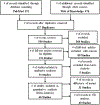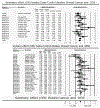DDT/DDE and breast cancer: a meta-analysis
- PMID: 24021539
- PMCID: PMC11298241
- DOI: 10.1016/j.yrtph.2013.08.021
DDT/DDE and breast cancer: a meta-analysis
Abstract
The biological basis for investigating dichlorodiphenyltrichloroethane (DDT) exposure and breast cancer risk stems from in vitro and animal studies indicating that DDT has estrogenic properties. The objective of this study was to update a meta-analysis from 2004 which found no association between dichlorodiphenyldichloroethylene (DDE) and breast cancer. We searched PubMed and Web of Science for studies published through June 2012 assessing DDT/DDE exposure and breast cancer. Summary Odds Ratios (ORs) with 95% confidence intervals (CIs) were calculated for the prevalence of breast cancer in the highest versus the lowest exposed groups for DDT and DDE. Difference of means of exposure for cases versus controls was analyzed for DDT and DDE. From the 500 studies screened, 46 were included in the meta-analysis. Slightly elevated, but not statistically significant summary ORs were found for DDE (1.05; 95% CI: 0.93-1.18) and DDT (1.02; 95% CI: 0.92-1.13). Lipid adjusted difference of means analysis found a significantly higher DDE concentration in cases versus controls (11.30 ng/g lipid; p=0.01). No other difference of means analysis found significant relationships. The existing information does not support the hypothesis that exposure to DDT/DDE increases the risk of breast cancer in humans.
Keywords: Breast cancer; DDE; DDT; Meta-analysis; Systematic review.
Published by Elsevier Inc.
Figures
Similar articles
-
Plasma levels of dichlorodiphenyldichloroethene (DDE) and dichlorodiphenyltrichloroethane (DDT) and survival following breast cancer in the Carolina Breast Cancer Study.Environ Int. 2019 Apr;125:161-171. doi: 10.1016/j.envint.2019.01.032. Epub 2019 Feb 1. Environ Int. 2019. PMID: 30716576 Free PMC article.
-
DDE and DDT in breast adipose tissue and risk of female breast cancer.Am J Epidemiol. 1999 Sep 1;150(5):453-8. doi: 10.1093/oxfordjournals.aje.a010033. Am J Epidemiol. 1999. PMID: 10472944
-
Dichlorodiphenyldichloroethane burden and breast cancer risk: a meta-analysis of the epidemiologic evidence.Environ Health Perspect. 2004 Feb;112(2):207-14. doi: 10.1289/ehp.112-1241830. Environ Health Perspect. 2004. PMID: 14754575 Free PMC article.
-
Pesticide exposure: human cancers on the horizon.Rev Environ Health. 1999 Jan-Mar;14(1):39-50. doi: 10.1515/reveh.1999.14.1.39. Rev Environ Health. 1999. PMID: 10372419 Review.
-
Pesticides and breast cancer risk: a review of DDT, DDE, and dieldrin.Environ Health Perspect. 2001 Mar;109 Suppl 1(Suppl 1):35-47. doi: 10.1289/ehp.01109s135. Environ Health Perspect. 2001. PMID: 11250804 Free PMC article. Review.
Cited by
-
DDT Exposure in Utero and Breast Cancer.J Clin Endocrinol Metab. 2015 Aug;100(8):2865-72. doi: 10.1210/jc.2015-1841. Epub 2015 Jun 16. J Clin Endocrinol Metab. 2015. PMID: 26079774 Free PMC article.
-
Environmental Contaminants Modulate Breast Cancer Development and Outcome in TP53 p.R337H Carriers and Noncarriers.Cancers (Basel). 2022 Jun 19;14(12):3014. doi: 10.3390/cancers14123014. Cancers (Basel). 2022. PMID: 35740679 Free PMC article.
-
Plasma levels of dichlorodiphenyldichloroethene (DDE) and dichlorodiphenyltrichloroethane (DDT) and survival following breast cancer in the Carolina Breast Cancer Study.Environ Int. 2019 Apr;125:161-171. doi: 10.1016/j.envint.2019.01.032. Epub 2019 Feb 1. Environ Int. 2019. PMID: 30716576 Free PMC article.
-
EDC-2: The Endocrine Society's Second Scientific Statement on Endocrine-Disrupting Chemicals.Endocr Rev. 2015 Dec;36(6):E1-E150. doi: 10.1210/er.2015-1010. Epub 2015 Nov 6. Endocr Rev. 2015. PMID: 26544531 Free PMC article. Review.
-
Exposure to environmental chemicals and cancer risk: epidemiological evidence from Japanese studies.Genes Environ. 2023 Mar 22;45(1):10. doi: 10.1186/s41021-023-00268-3. Genes Environ. 2023. PMID: 36949525 Free PMC article. Review.
References
-
- ATSDR. Agency for Toxic Substances and Disease Registry. 2002. Toxicological Profile for DDT, DDE, and DDD. - PubMed
-
- Ahmed MT, Loutfy N, et al. (2002). "Residue levels of DDE and PCBs in the blood serum of women in the Port Said region of Egypt." J Hazard Mater 89(1): 41–48. - PubMed
-
- Aronson KJ, Miller AB, et al. (2000). "Breast adipose tissue concentrations of polychlorinated biphenyls and other organochlorines and breast cancer risk." Cancer Epidemiol Biomarkers Prev 9(1): 55–63. - PubMed
-
- Aubé M, Larochelle C and Ayotte P (2011). "Differential effects of a complex organochlorine mixture on the proliferation of breast cancer cell lines." Environmental Research 111: 337–347. - PubMed
-
- Bagga D, Anders KH, et al. (2000). "Organochlorine pesticide content of breast adipose tissue from women with breast cancer and control subjects." J Natl Cancer Inst 92(9): 750–753. - PubMed
Publication types
MeSH terms
Substances
Grants and funding
LinkOut - more resources
Full Text Sources
Other Literature Sources
Medical
Miscellaneous




